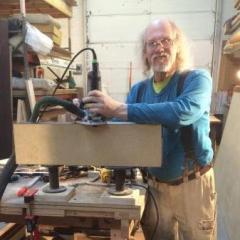-
Posts
371 -
Joined
-
Last visited
About BuilderBill
- Birthday October 3
Contact Methods
-
Website URL
http://www.billgrahamphotography.com
-
Twitter
billg71
Profile Information
-
Gender
Male
-
Location
lost in the Hotlanta 'burbs
-
Woodworking Interests
residential framing, siding and trim, hand tools, furniture making, just building whatever "stuff" I happen to need...
BuilderBill's Achievements

Journeyman Poster (2/3)
55
Reputation
-
Ben, If i remember(and that's saying a lot) I just bought a standard shop vac hose (8'?? 12'??) from the Homeless Despot or maybe Lowes and cut it to length. It takes some knife work to get the fitting out of the hose but then it just screws into the piece you want to use. The 90-degree ell came from Incra https://www.incrementaltools.com/PARTS_INCRA_Wonder_Fence_p/pc-wonderfence.htm, part 9 in the illustration. Enjoy the Fien! Best, Bill
-
I've used el-cheapo vinyl window shades mounted to the ceiling laid out like your foam panels. Set your box fan/filter on a table and cut the rear shade to fit, tape it to the shade and you're good to go. I don't know what you'd do for the ceiling, mine hung from the lumber rack.
-
Dust collection at the source is always the optimal solution. That requires relatively expensive equipment(a HEPA vac or DC system) and doesn't work with solvent vapors(unless you build a spray booth into your garage). So an exhaust fan will work if it moves enough air, just remember that what goes out must come in. If the air going out doesn't come in through the garage door or an open window it'll come from somewhere and that could be your furnace/water heater flue. If that's the case you'll definitely be sucking CO into your garage, not a good thing. BUT: If you live in a new house or had your furnace/water heater replaced in the last 10 years both those appliances will draw outside air for combustion. You can tell if there's PVC pipe from them going to an outside wall instead of a metal flue pipe going up to the roof. If that's the case then all the exhaust fan will be sucking out(no windows open) will be the air you spent money on to heat or cool. A respirator is always a good idea, stick with 3M. They're relatively inexpensive on Amazon and you can get either dust or organic solvent cartridges. But if you don't have a HE furnace and water heater you might want to stay away from stains and finishes that use organic solvents, the fumes don't play well with open flame.
-
I've used this with good results: SR500 Industrial Sound Damping, got the idea from David Marks. I've also used Dynamat which costs more but is easier to apply if you don't have the machine apart. Both are good on sheet metal parts, especially large panels. I don't know where you buy the Silent Running, when I got it they were selling direct. They have a dealer locator on their site but it appears there isn't a source within 500 miles of me. Maybe you could call them and get them to ship you some if there's not a dealer in your area. As pointed out, most machine noise is generated by the cutting action and no amount of sound damping on the tool will help with that. I have Byrd heads on my planer and jointer and they're remarkable for noise reduction(among other things). Industrial table saw blades are designed to reduce noise so that helps a bit. But there isn't anything that's going to quieten down a universal motor or the sound from a router bit cutting at 20K RPM. That's where rock wool and RC-1 channel come into play.
-

Should I or shouldn’t I ? Older ROCKWELL bandsaw
BuilderBill replied to Clark'swoodworkings's topic in Power Tools
If you're good with replacing bearings then jump on it. -
Really nice router with the best dust collection(and I have the OF1400). If you can get a used one for $100 that hasn't been beat to heck jump on it. My only complaint is with the trigger lock but if you're used to the 625 that won't be a problem.
-
I've seen this before but listening to old WT podcasts got me interested so I checked out their website: https://shapertools.com/ I actually pre-ordered one, if you want to do the same use this link and save both of us $100: https://preorder.shapertools.com/ref/8CXJG2NKF Or just discuss, say what you think. Best, Bill
-
I remember several years ago FHB posted this "technique" as a video on April Fool's Day. I never thought anyone would actually try it. And WTH is this posted in "The Wood" forum anyway?
-
Silly wabbit, Twix is for kids! Sorry, couldn't resist...
-
Are you sure you're not overthinking this a bit? It's a hall closet all said and done....
-
WTH is a CBG? Cigar Box Guitar?
-
"Oh, crap" isn't exactly what I'd have said but you're commended for the family-friendly language. Just wanted to add that if you turn the saw on(the small main power switch) and let it initialize, you can run the miter gauge/jig/whatever past the blade and if there's a potential trigger the red LED will flash rapidly and the paddle switch for the motor won't power it up for the next 5 seconds. Quick check for anytime you're using a miter gauge or tenon jig. Might save someone $70-80 for a brake cartridge and more than that for a blade.
-
The problem with the old orbital sanders is that they leave pigtails in the surface no matter how you run them. That's why everybody uses RO sanders, they're a better mousetrap. You could cut an 8-1/2x11 piece of plywood, put it on top of your sandpaper sheets and use the sander to weight it down and keep them flat. Or just realize it's an obsolete technology and pitch it in the trash. As far as sanding finish between coats, if you need a sander to do that you need to work on your finishing chops.
-
Forget the Festool sanders, get a Mirka Ceros. Or a 3M or Mirka air sander and a monster compressor to run it. There is a difference and the big-box sanders don't come close in handling or performance. Even the Green ones. It's well worth the money. Yes Virginia, there is a Santa Clause and he'll bring you a yellow systainer if you've been really, really good.
-
So go get yourself a sheet of plywood, rip it, glue it together, edge it, sand it, paint it and see how much time you have invested. Multiply that by 8, add maybe 8 hours for installing the flanges and pipe, another four or so hours for delivery and setup and you have a man-hour number. Multiply that by what you need to make per hour and add on another 15% for overhead. When you have that total add on another 15-20% for profit. Don't forget to mark up materials at least 10% to cover waste and possible screwups. Friends being friends and all that, your friend isn't writing the checks and I'd be willing to bet he didn't get you any kind of discount on your membership. Business is business, you're in it to make a profit and if you can't do that it's a lot easier to sit home and watch TV or work in your shop on personal projects. If you can't get a reasonable return on time and materials, don't be afraid to turn down the job. I've been in the construction business for 35 years and some of my best jobs were the ones I didn't get. I have better things to do than work for wages, if I wanted to do that I'd have a day job and a lot less headaches. My $.02 worth, Bill





